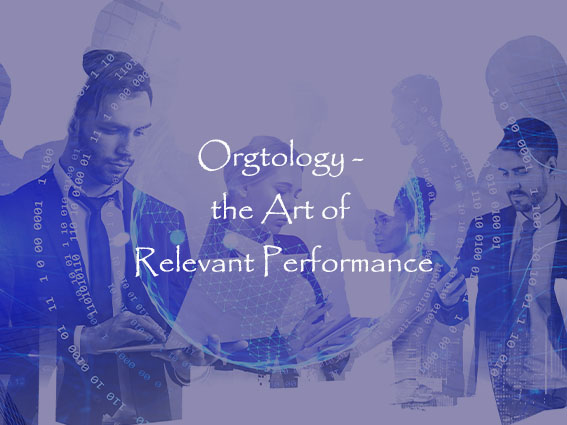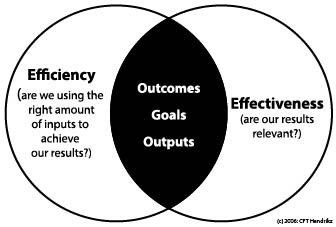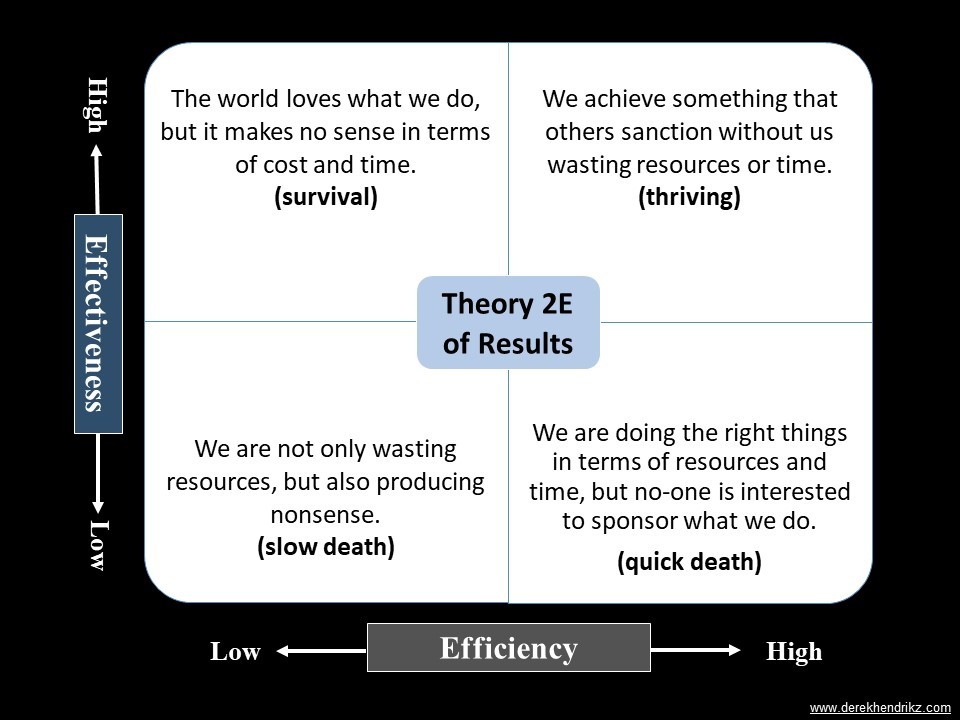The Orgtology Blog
Theory 2E – Understanding Workplace Results
Theory 2E measures the outputs and outcomes of an organisation. I.e., it probes the results of our operations and strategic initiative. An output is the result of a process. When Org defines its activity, sequence, and rules, it creates outputs. A simple example is building a car. The car is an output. Whether people like the car, will buy the car, or see it as value for money, are outcomes. An outcome is an assessment of how an environment responds to an output. It thus shows the effect of an output. A target is a quantified prediction of what an output or outcome will show. In Theory 2E, efficiency measures outputs, whilst effectiveness ensures outcomes. According to Hypothesis 2x, efficiency is a receptive item and effectiveness a projective item.
The basic assumption behind Theory 2E of Results
If outcomes assess outputs, then Org must negotiate its outcomes and control its outputs, because the former will secure relevance whilst the latter will ensure performance. This is the difference between effectiveness and efficiency.
In Theory 2E, the "2E" shows the two metrics that can influence and empower the results of Org. They are efficiency and effectiveness. Efficiency measures performance, whilst effectiveness measures relevance.
The difference between efficiency and effectiveness
People often use the terms "efficiency" and "effectiveness" interchangeably. To explain their difference, most quote Peter Drucker. His definition is "Efficiency is doing the thing right. Effectiveness is doing the right thing." I like this definition, yet I struggle to find good explanations of it. "Efficiency is about improving how we work, while effectiveness is to achieve a goal." That is the most common explanation. My problem is that it does not ensure a relevant goal. In orgamatics, relevance is the whole point of effectiveness. Org often creates things that never sell; sets up needless departments; approves duplication of work; etc. Achieving a goal does not make something effective. The outputs that we create must be relevant to an environment. This means that effectiveness and efficiency do not have a linear relationship. They must co-exist as two interdependent parts. Efficiency is doing things right. Effectiveness is doing things that are relevant.
Politicians often say: "we must be efficient and effective." Is this possible? It might even be an oxymoron. Efficiency implies a reduction in energy without a reduction in output. That is not a concern to those who use your product or service. When you enter a bank, you want to see ten tellers behind the ten teller points. That would ensure the effect that you expect. The banks efficiency measures are not the customers concern. Often as much as four doctors and five nurses do a caesarean delivery. This is not efficient, since one doctor and two nurses could do the same thing. Yet, a patient would want as much experts involved as possible. This would include a paediatrician, a gynaecologist, an anaesthetist, and an assistant doctor. Therefore, effectiveness is often at the cost of efficiency. The problem is that Org can only control its efficiency. E.g., I can claim efficiency on writing this post. But I cannot claim effectiveness. The readers of this post will decide its effect. In so, Org can claim its efficiency, but its environment will judge its effectiveness.
To be effective, we must often subordinate the use of energy to the achievement of a goal. It is possible, to do a caesarean delivery with one doctor, but the customer will prefer four. It is possible to serve all bank customers with one teller, but those in the que, will prefer five. What Org needs, often conflicts with what customers want. This is healthy conflict. It forces us to consciously manage an equilibrium between energy and result.
Understanding efficiency
To be efficient, one must achieve a result without wasting energy or effort. We mostly say that someone is not efficient, when such a person wastes time or resources. Efficiency demands a meaningful relationship between work produced and energy used. Although this will ensure that we waste no energy, it will not assure the relevance of what we do. I.e., we could chop down a forest with engineering precision, and no wasted energy. Yet, there will be no guarantee that it is the right forest, or that chopping it down was the best choice.
In efficiency, outputs are the dividend and inputs create the divisor. It is not possible to get a meaningful answer when the divisor is zero. An input must thus exist before we can create an output. We measure what we get out against what we put in. The answer should always be equal or greater than one. I.e., we should always get more out than what we put in. If not the case, then we are not efficient.
Understanding effectiveness
Being effective implies that you produce a relevant result. E.g., if we hire a coach whose team wins the world cup, then the coach was effective. Winning was the reason for her appointment. Yet, achieving a result is not the only condition for effectiveness. The question is: "What is the effect of our outputs?" A result must always satisfy the sponsors and users. E.g., in a caesarean delivery, a physician was only effective if his patient perceived him to be so. If she loved the way that he treated her and where she recommends him to other patients, he was effective. In so, a team who wins the world cup, must also capture the hearts of their fans. And a boy, who declares his love to a girl through a letter, might get the effect he wants, or not. His letter could give her butterflies or a turning stomach. He controls the output, but not the effect. The girl will be the judge of that. Her perception will decide whether he is a knight in shining armour or a stalker. That is the dilemma of effectiveness – Org has little control over it.
Unlike efficiency, in effectiveness "output" is the divisor. It shows that an output must exist before we can test relevance. This has many consequences. E.g., it means that efficiency must exist before effectiveness can. It helps us to understand that intent means nothing without purpose. The same goes for leadership without management. It therefore makes sense to get your house in order before conquering the world.
We measure relevance against outputs. The answer must always be equal or greater than one. I.e., relevance must be greater than the cost of an output. Sustainable profit is first made on the perception of relevance, and then on cutting cost. The snag is, that it is mostly impossible to quantify relevance. You cannot quantify a belief. Relevance is a negotiation exercise and not one of operational engineering. Being efficient but not effective is a great waste of resources.
Efficiency and outputs vs. effectiveness and outcomes:
We use efficiency to rate the performance of an input. E.g., if the same sales team uses the same resources to make more sales, they are efficient. If they must increase resources to make more sales, then they are not efficient. However, it might be what they must do to stay in business. We use effectiveness to test the relevance of an output. Relevance is an external opinion. It is difficult to control. To optimise resources, we must learn from a repetitive past, and then adjust our processes. Yet, to be effective we must show strategic leadership and influence. Efficiency helps us to perform through understanding the past. Effectiveness keeps us relevant through accurately predicting an unknown future. To perform we must learn. To stay relevant, we must unlearn.
It is key to grasp the relationship between efficiency, effectiveness, outputs, and outcomes. I explain outputs, outcomes, and targets in another post. An output is the result of a process. An outcome is an external evaluation of an output. A target is a prediction of a future output or outcome. Because Org can control its outputs, it can be efficient. Org cannot control an external perception. The best it can do is to negotiate and influence a favourable perception. Org will get meaningful outputs through efficiency. In so it will achieve meaningful outcomes through effectiveness. When doing things right, we perform. When doing the right things, we stay relevant.
How to be both, effective and efficient
To know whether Org can be both, effective and efficient, we must correlate the concepts. E.g., A coach chooses the wrong team, and as result he loses the championship. He was ineffective. But if he trained that team optimally, he was still efficient. Let us say that the team won the championship. But they did so with abundant waste of resources. In this case the coach was effective, but at the cost of efficiency.
To rate efficiency, we must relate outputs to inputs. The implication is, that it is possible to have zero outputs. In other words, an organisation can put in a lot of effort and produce nothing. In this case, the efficiency is zero. The higher the output, in relation to its inputs, the higher efficiency will be. To test effectiveness, we must grasp how relevant our output is to an outside factor. Such factors can be demand, pleasure, or liking. For effectiveness, we must relate relevance to an output. It is possible that an organisation produces something that nobody wants or needs. In such case, effectiveness is zero. The more relevant an output is, the higher effectiveness will be.
To be efficient and effective one must know what is possible and achieve it by doing exactly what you must. Not more, nor less. To do so, one must understand one's ability and the relevance of such ability. This means that we must find a level of possible relevance. E.g., An environment demands 100 apples per month, but I only have the resources and capacity to produce 40. In so, I can only possibly be relevant to 40% of the demand. This means that to be effective, I must reduce the demand to what I can supply, and then get others to buy such. In so, to be 100% effective, I must set the demand at 40, out of the 100 apples demanded; and then produce the same. And where I use exactly the right amount (or less) inputs to achieve the output of 40 apples, I will also be 100% efficient. In this case, I am successful in both, my operations, and my strategy. Focus on the goal and do exactly what you need to do to achieve that. But mostly, be sure that what you set out do, is something relevant.
Practical application
On 01 January 1990, Rowan Atkinson launched Mr. Bean. A low-cost production that captured the hearts and minds of the world. Today Atkinson is worth about 130 million USD. This a beautiful example of how efficiency and effectiveness create results.
In the presence of relevance, efforts to be effective are inefficient. When you have a monopoly, your only concern is efficiency. The contrary to this is as true. In absence of relevance you will not have much time for efficiency. That is why the sketch below has a solid block for efficiency and a white circle for effectiveness. The size of the circle will depend on how relevant you are. If you are not relevant you will have to hunt opportunities, endure customer abuse, take huge risk, etc. If you are relevant, then focus on employee performance, cost, processes, etc.
Conclusion
The effect of Theory 2E is that in lack of relevance it will be difficult to perform. This is because you will be spending your energy and time to find sponsorship. In lack of efficiency, you will find it difficult to make ends meet. Be efficient in the things you must do, so that you can be effective in the things you want to do. There is no magic to this. It is what it is.

Join the Orgtologist Certification Program (OCP) - Empowering Executive Teams Worldwide
Copyright
© 2019-09-29: Derek Hendrikz
When you subscribe to the blog, we will send you an e-mail when there are new updates on the site so you wouldn't miss them.







